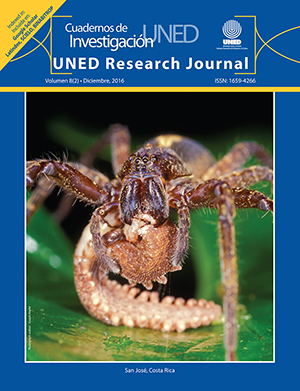Papeles invertidos: arañas depredadoras de gusanos de terciopelo neotropicales (Epiperipatus spp.; Onychophora: Peripatidae).
DOI:
https://doi.org/10.22458/urj.v8i2.1557Palabras clave:
Comportamiento depredador, invertebrados neotropicales, veneno de araña y onicóforos.Resumen
Los gusanos de terciopelo (Onychophora) son antiguos depredadores de origen cámbrico que ocasionalmente consumen arañas cténidas. Aquí informamos el caso contrario: arañas (Ctenus spp.) alimentándose de gusanos onicóforos (Epiperipatus spp.) en Colombia y Costa Rica. Aparentemente las presas no lograron expulsar su red defensiva y la eficacia del veneno de araña sugiere que los nervios y músculos de los onicóforos son bioquímicamente equivalentes a los de los insectos.Citas
Concha, A., Mellado, P., Morera-Brenes, B., Costa, C. S., Mahadevan, L., & Monge-Nájera, J. (2015). Oscillation of the velvet worm slime jet by passive hydrodynamic instability. Nature communications, 6: 6292.
Cook, D. R., Smith, A. T., Proud, D. N., Víquez, C., & Townsend Jr, V. R. (2013). Defensive responses of Neotropical harvestmen (Arachnida, Opiliones) to generalist invertebrate predators. Caribbean Journal of Science, 47(2-3), 325-334.
Dias, Sidclay C., & N. F. Lo-Man-Hung. (2009): “First record of an onychophoran (Onychophora, Peripatidae) feeding on a theraphosid spider (Araneae, Theraphosidae).” Journal of Arachnology, 37 (1), 116-117.
Hernández-García, V., Martín, A. Y., & Castro, J. J. (2000). Evidence of external digestion of crustaceans in Octopus vulgaris paralarvae. Journal of the Marine Biological Association of the UK, 80(03), 559-560.
MAVDT. (2008). Parque Nacional Natural Tamá: Plan de Manejo 2006 – 2010. Bogotá: Ministerio de Ambiente, Vivienda y Desarrollo Territorial.
McGlynn, T. P., & Kelley, C. D. (1999). Distribution of a Costa Rican wet forest velvet worm (Onychophora: Peripatidae). Annals of the Entomological Society of America, 92(1), 53-55.
Monge-Nájera, J., Barrientos, Z., & Aguilar, F. (1993). Behavior of Epiperipatus biolleyi (Onychophora: Peripatidae) under laboratory conditions. Revista de Biología Tropical, 41(3 A), 689-696.
Monge-Nájera, J., & Hou, X. (1999). 500 Millones de años de evolución: onicóforos, los primeros animales que caminaron (Onychophora). Boletín SEA, 26, 171-178.
Monge-Nájera, J., & Hou, X. (2000). Disparity, decimation and the Cambrian” explosion”: comparison of early Cambrian and Present faunal communities with emphasis on velvet worms (Onychophora). Revista de Biología Tropical, 48(2-3), 333-351.
Monge-Nájera, J., & Morera-Brenes, B. (2015). Velvet Worms (Onychophora) in Folklore and Art: Geographic Pattern, Types of Cultural Reference and Public Perception. British Journal of Education, Society & Behavioural Science, 10(3), 1-9.
Okamoto, C. K., Queiroz, G. P., Gutierrez, V. P., de Almeida, D. M., Cury, Y., Bertani, R., Okamoto, C. K., Queiroz, G. P., Gutierez, V. P., de Almeida, D. M., Cury, Y., Bertani, R., & Tambourgi, D. V. (2009). Ctenus medius and Phoneutria nigriventer spiders venoms share noxious proinflammatory activities. Journal of Medical Entomology, 46(1), 58-66.
Read, M. (1985). Stalking the Collared Peripatus. Natural History, 94 (9), 56.
Read, VM St J. & R. N. Hughes. (1987): “Feeding behaviour and prey choice in Macroperipatus torquatus (Onychophora).” Proceedings of the Royal Society of London B: Biological Sciences, 230 (1261), 483-506.
Descargas
Publicado
Cómo citar
Número
Sección
Licencia
Nota: Este resumen contiene un copyright incorrecto debido a problemas técnicos. Los autores que publican en esta revista aceptan los siguientes términos: Los autores conservan los derechos de autor y otorgan a la revista el derecho de primera publicación, con la obra simultáneamente bajo una Licencia de Atribución de Creative Commons que permite a otros compartir la obra con el reconocimiento de la autoría y la publicación inicial en esta revista.
Los contenidos se pueden reproducir citando la fuente según la licencia de Acceso Abierto CC BY 4.0. El almacenamiento automático en repositorios está permitido para todas las versiones. Incentivamos a los autores a publicar los datos originales y bitácoras en repositorios públicos, y a incluir los enlaces en todos los borradores para que los revisores y lectores puedan consultarlos en cualquier momento.
La revista está financiada con fondos públicos a través de la Universidad Estatal a Distancia. La independencia editorial y el cumplimiento ético están garantizados por la Comisión de Editores y Directores de Revistas de la UNED. No publicamos pautas publicitarias pagadas ni recibimos financiamiento de la empresa privada.
